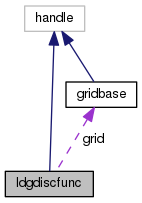|
rbmatlab
1.16.09
|
an ldg shape functions implementation
Definition at line 17 of file ldgdiscfunc.m.


Public Member Functions | |
| ldgdiscfunc (varargin) | |
| initialize ldg function on triangular grids with input More... | |
| function | display () |
| function res = | evaluate (eindices, lcoord) |
| function res = | subsasgn (S, val) |
| function res = | subsref (S) |
| function sdf = | scalar_component (ncomp) |
| extraction of scalar component of vectorial ldg function More... | |
| function p = | plot (params) |
| plot as colormap More... | |
Public Attributes | |
| nelements | |
| number of elements | |
| pdeg | |
| polynomial degree | |
| ndofs_per_element | |
| number of DOFs per grid elment | |
| ndofs | |
| number of DOFs | |
| dimrange | |
| dimension of range space | |
| dofs | |
| the DOF vector | |
| ::gridbase | grid |
| grid object | |
| ldgdiscfunc.ldgdiscfunc | ( | varargin | ) |
initialize ldg function on triangular grids with input
note, the only use of this class is, that by local storage of the dof vector and a (..) as evaluation routine, these objects can be used identically as analytical functions in integration, matrix assembly, etc. But in general the ../ldg directory contains methods for handling ldg functions based on seperate dof and parameter storage. These methods are more efficient as the class&methods.
i.e. dofs with number 1,1+dimrange,1+2 dimrange ... are the dofs of the first scalar component, etc.
let \(\hat phi_i i=1...m\) be an orthonormal basis on the reference triangle \(\hat T\). Let T be an arbitrary triangle and \(F_T\) be the reference mapping from \(\hat T\) to \(T\). Then for all global dof indices \(j=1,...,N\) there exists an element \(T(j)\) and local index \(i(j)\) such that \(phi_j (x) = \hat phi_i(j) ( F_T^-1(x))\)
Then an ldg-discrete function is given by
\[ df (x) = sum_j=1^N dof(j) * phi_j(x)= sum_j=1^N dof(j) * \hat phi_i(j) (F_T(j)^-1 (x) )= \]
| varargin | varargin |
Definition at line 86 of file ldgdiscfunc.m.

| function ldgdiscfunc.display | ( | ) |
| function res = ldgdiscfunc.evaluate | ( | eindices, | |
| lcoord | |||
| ) |
| function p = ldgdiscfunc.plot | ( | params | ) |
plot as colormap
| params | params |
| p | p |
Definition at line 198 of file ldgdiscfunc.m.
| function sdf = ldgdiscfunc.scalar_component | ( | ncomp | ) |
extraction of scalar component of vectorial ldg function
| ncomp | ncomp |
| sdf | sdf |
Definition at line 184 of file ldgdiscfunc.m.

| function res = ldgdiscfunc.subsasgn | ( | S, | |
| val | |||
| ) |
Definition at line 18 of file subsasgn.m.
| function res = ldgdiscfunc.subsref | ( | S | ) |
 1.8.8
1.8.8